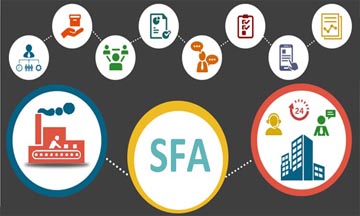
The mechanics of B2C selling in emerging markets such as India is entirely different from B2C context in most OECD countries, and of course fundamentally different from B2B context. Unorganized retailing heavily dominates retail infrastructure in markets such as India. Further it is predominantly offline, in some consumer goods, it makes more than 90% of all retailing. This is even more pronounced in rural and outside major cities. Here by organized retail, I mean selling via retail chains such as Walmart/BigBazaar etc and unorganized retail as in sales via small independent retail outlets.
Hence it becomes important to understand the differences of these two sale contexts to appreciate the requirement differences before selecting an automation strategy.
I have divided analysis of differences under following broad heads:
- Sales function differences
- Touchpoint differences
- Deal size differences
- Sales Cycle differences
- Target Customer differences
- Promotion and campaign differences
- Operations Management Differences
Sales function differences
In B2B scenario, the Sales Function is primarily a task of solving problem for a customer and positioning the company and its products. Sales front man deals with end customer and must find the right target stakeholders to gain traction. In this sense, Sales function in B2B context often uses terms as ‘Navigating’ or ‘Orchestrating’ in relation to making a sale, as it’s a complex process with multiple stakeholders, dimensions involved in decision making that require highly skilled manoeuvring. Thus, the key success criteria for Sales function is ability to solve customer problem. Hence, not surprisingly, often key qualification to be successful is domain expertise of customer context. Thus, the sales teams are usually organized by industry/domain expertise.
In contrast, in unorganized retail chains driven sales, primary task of Sales function is to act as eyes and ears of the organization and often Sales operation is intermixed with field marketing function. At macro level, the Sales department performs similar function, that of contributing towards product-market fit and thus solving end customer problem, however at individual field staff level, primary success criteria is that of operations effectiveness- which includes aspects like regular visits to key customers (who are retailers, dealers), ground up support (e.g. promotional material, providing consumer leads etc), organization support (e.g. addressing concerns, material returns etc). Additionally, since the number of retail outlets is usually big, often spread out over large geographies including in remote locations, the sales team are organized by geography and knowledge of local conditions is useful, but not limiting.

Touchpoint differences
In B2B scenario, since deals are complex, multiple stakeholders are involved, such as decision maker, budget holder, influencer, evaluator, process owner etc. Thus, in order to successfully ‘navigating’ a deal, the Sales must ensure concerns for different stakeholders are defined and their concerns addressed. Thus, multiple touchpoints, their roles, audit history of communication etc are crucial to success, often managed via different persons in selling organization.
In contrast, the Sales operations in retailer chain selling scenario usually deals with a single stakeholder, who is usually the owner of the retail business. Its enough to have information about contacts, concerns, requests and dealings of a single person involved.

Deal size differences
In B2B scenario, the deal size tends to be large which, naturally, involves much more involved decision making. Length of Sales cycle, number of stakeholders, deal complexity are all functions of this characteristic.
In contrast, in the unorganized retail based selling context, multiple small orders is the norm, thus operational effectiveness, logistics are crucial aspects to ensure retailer continues to stock and promote organization’s products.

Sales Cycle differences
In B2B scenario, the sales cycle is often long, running into months if not quarters until all stakeholders, organizations purchase processes have been satisfied. Thus, keeping track of a long running cycle and various dimensions of the opportunity are a crucial factor.
In unorganized retail based selling, sales cycle as a term is irrelevant, it is purely a function of end customer demand, retailers loyalty and logistical capability of the organization.

Target Customer differences
The typical B2B customer is an enterprise signing up for a long term relationship. Dealing in such context requires multiple engage points and Investments. Investing adequate resources is required for each opportunity given differences in each deal, long sales cycle, multiple stakeholders, not to mention highly skilled personnel required for execution.
In unorganized retail driven selling, retailer is usually a small business more interested in ensuring organization is focused on creating bottom up (end customer) demand in his region and addressing his concerns regarding margins, logistics and supply. Winning and retaining owner loyalty is crucial via repeated operations, like regular visits, incentives etc.

Promotion and campaign differences
In B2B scenario, nature of campaigns is very different because target customer base is relatively small and usually reached via references, visits, events or selected media options. Thus typically, promotions and campaigns are designed to generate in person meeting opportunities. The impact of competitor campaigns are limited, usually not crucial to deal closure as sales battles are won or lost over the long running sales cycles.
In contrast, promotions and campaigns in unorganized retail chains driven selling context are large budget exercises, run frequently and designed to influence end customer for purchase decision. The effect of competitor activity is crucial since promotions are designed to influence customer decision. Role of retailer is important because often retailer is seen as a local trusted advisor, who influences end customer decision. Thus, promotions are not always advertising activities targeted at end customer, but marketing schemes incentivizing retailer to promote organization products and brands. Since, these tend to numerous, often localized (ie available in select geographies) and crucial to market success, keeping track of competitor campaigns, launching counter campaigns in response in a timely manner is crucial.

Operations Management Differences
Operations management in B2B increases as the Sales cycle progresses to later stages as tracking multiple activities and stakeholders concerns are crucial. Operations management in pre-sales cycle stages are more focused on lead management and qualification to ensure resources are appropriately allocated. Given the deal size, smaller customer base, the number of field staff focused on customers are relatively less but senior, highly skilled experts. Thus, operations are often managed and tracked by individual leads. This includes ensuring once a lead is qualified, it is pursued effectively with appropriate diligence and resources.
Operations management in unorganized retail based sales is fundamentally different. Lead management is mostly irrelevant, since orders are a function of consumer demand and mostly flow without effort if end customer demand continues to be generated. Operations management, however, is focused on servicing the market effectively by regular visits, gathering market intelligence (this is the cornerstone of operations in B2C), logistics and smooth order taking & processing. Given the large number of micro markets, large geographic spread, relatively large number of field staff employed, operations management also requires defining policies for visits and tracking compliance to organization policies & practices (such as frequency of regular visits, returns processing etc).

Summary
I have summarized the highlights of differences analysed above in following table:

Conclusion
In this blog, I have included some points to outline how selling is fundamentally different in B2B context vs selling via unorganized retail chains. Please note, reference here is to unorganized retail chains driven sales, not all B2C context which includes selling via organized retail (large retail chains), which has some common characteristics to B2B context.
In this light, it becomes important to realize that solutions required to run such operations is fundamentally different in these contexts. In my next blog I will be detailing the implications of these differences on the automation strategy for brands selling via unorganized retail chains.
Hope you enjoyed reading it,







